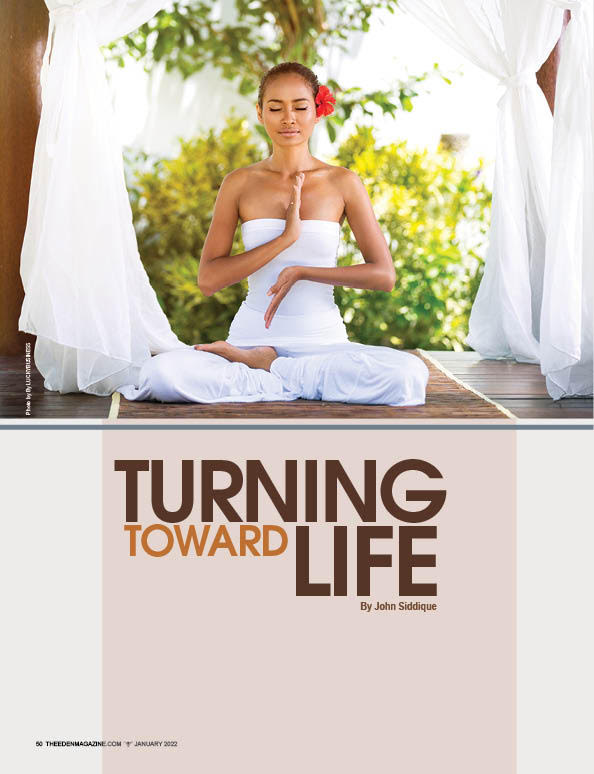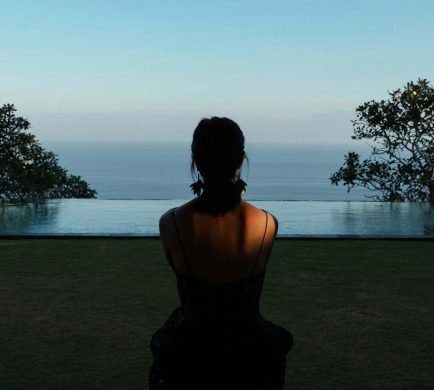By John Siddique
An excerpt from Signposts of the spiritual Journey
Regardless of what brings you to the path, the first signpost is always marked by the arising of questions. Of course, you will read or hear about a rare few people who spontaneously awaken. But we can’t guarantee that outcome or wish ourselves into being one of them; only grace brings awakening in the long or short run; everything else is your journey.
You are you, and where you are at this moment is where you are. The here and now is the key to everything. When awakening takes place, it will always be spontaneously through grace, and never because we’ve struggled for or wished or intentioned such a thing. Yet like a gardener learning to plant a garden, we may prepare our earth by feeding the soil, understanding the cycles of the sun, the moon, the rain, and the earth, creating the best conditions for the seed to open, to flower, and fruit. We also discover along the way that a cherry tree cannot become an apple tree, and vice versa, no matter how much we might wish it. As we move into greater awareness, we discover the great miracle of the garden of our own ordinary life.
At this point, you might find yourself questioning what is going on in the world around you, or you may be questioning the purpose of your own life. Anyone who dares to reflect on life and its meaning find that things tend to boil down to three
primary questions. I’ll just place the three questions here without commentary because you know them already, and, in essence, they are why you are here. You have always known these questions.
Who am I?
What am I here for?
Is there a way to end suffering?
Seven other secondary questions feature prominently throughout the journey, which you will similarly find you already know:
Who? What? Why, Where? When? What if? How?
PAUSE FOR REFLECTION
I invite you to pause for a minute and reread the ten questions above slowly to yourself and see where you feel them in your body, or your energy, concerning your life’s journey. You may want to introduce these questions into your journaling from time to time.
Learning to turn toward awareness
You can notice or even encourage a shift within yourself toward awareness by the way you frame your questions as you meet daily life situations. For example, if we allow a movement from asking questions such as “Why is this person doing this to me?” or “Why is (insert difficult personal situation) always happening to me?” and instead try to drop taking the situation personally, and allow appreciation of any other person involved, then we’re not coming from the place of it being a problem. Then we can ask things such as:
How can I bring awareness to what is going on?
What if I choose to respond rather than react?
What really would improve the world?
How do I step out of my way to transcend this situation?
What if I choose to love and forgiveness with this other person?
Notice how these more reflective questions lead to greater awareness if we drop our resistance and allow the momentary vulnerability that comes with this turning around. If asked with this openness, all of our ten initial questions will take you toward a better way of meeting and experiencing your own life and other people. We restore our humanity instantly and easily with a simple shift.
As you begin to work more consciously like this, you will start to find that each question contains its own answer. With all of this work, I would encourage you not to search too hard for answers in your mind. Thinking is wonderful and has its place, but we can often go much further by dropping into our hearts and letting the question just exist within ourselves. This way, too, we begin to be able to stay more open and curious about life. The mind will always come up with its usual commentaries, of course – “Yes,” “No,” “How stupid this is,” and so on. Yet as your awareness deepens, you will see that the mind in this mode is only doing its job of trying to protect you by digging into what it already knows as it searches for what to do. The mind without heart and awareness only knows what it has been conditioned with from the process of socialization. This often keeps us limited in our ability to respond and close to much of life while unknowing of our real depths and basic goodness.
Our training usually tells us that someone else is responsible for everything that happens to us, and we may be reactive to even the slightest hint of allowing vulnerability. It can seem that our happiness, love life, situations, health, spirituality, and so on are either the luck of the draw or something we have to work very hard at to achieve. Our socialization training also tells us that we need to become a “somebody” who does things in a certain way to have a place in the world, beloved, be fed, belong, and be of value as a human being.
We tend to believe that these outward motions of thought energy are our lives. This belief makes it seem like the answers we seek can only be found if we are smart enough or have the right “life situation” or set of experiences in place. Yet no matter the situation, the voice of the soul is in there asking you: Who am I? What am I here for? As your deeper side starts to communicate more clearly, you might find that you feel that whatever you do is not enough to actually complete you or fulfill you fully. Please know this feeling is a good thing as it is the desire for wholeness. So
all we want to do here is move beyond just feeling that and into a gentle place of unfolding that brings us into knowing our soul. Each of us can know and experience our soul and let our lives be shaped by it. This is the meaningful life we are talking about. This is the journey of awakening or enlightened living.
Before we know this and accept and appreciate the daily steps of our journey, we try pushing deeper into clinging to the conditional objects that we meld our identities with. We push with intensity into our emotional sphere. “I just need more,” we say, or we just keep trying to switch things out to find a fit that will make us whole. “Perhaps this isn’t the right house, or car, or relationship.” We might lean into the pain of our past: “It’s what happened in my family when I was young.” Or: “If only we got rid of all of this kind of person, the world would be alright.” Notice how these motions of thought into this type of feeling always seek separation or duality. Then it presents one side of the duality as the answer.
PAUSE FOR REFLECTION
I invite you to kindly take a few minutes to reflect on your self-talk toward yourself and others. Let’s not look for guilt or shame, but we’re doing this just to see what is there, even if that is blanking out when you try to bring your attention to this place. The first step toward meaningful change is always acknowledgment of the problem. We meet it as best as we can at this particular time. The second step is to say “hello” to it rather than “go away”, and this genuinely will change everything. Perhaps try this with what is arising in you right now. Can you just say hello with your kindness and love and let it be there? What happens next?
The journey begins
It is said that the longest journey in human life is the journey from the head to the heart. It is of paramount importance that we meet our lives, these questions, and what comes from them at the level of the heart. The ordinary mind has a tendency to be reactive from its unconsciousness, which pushes and pulls us, trying to get us to our satisfaction or safety. We do need, at some small level, to satisfy our heads, but enlightenment or awakening is not something you can think your way to – if that were so, the world would look very different than it does right now. The ordinary heart at least has the possibility of emotional engagement, and the heart is rightly seen by so many of the world’s spiritualities as one of the great doorways to truth and the deepest awareness within us that we might call the soul.
A SMALL HEART AWARENESS PRACTICE
I invite you to sit upright and simply be aware of the space of the room around you; please don’t try to go into or have a meditational experience. Rather, just allow yourself as best you can to be here and to feel the space of the room around you.
Allow yourself to feel the energy in your body while feeling the space in the room so that you have a physical sense of the life in your body.
As you become more aware of the space in the room and the energy of your body, you might notice that perhaps you feel it more in one hand or one leg, perhaps as vibration, or heat, or sensation. It’s all okay.
Allow yourself to be easy for these few moments, don’t concentrate or over focus, just use feeling and felt sense as best you can.
You can close your eyes if you like.
(Oh, now you can’t read the page.)
Just take a moment like this.
I invite you now to simply place one hand on your heart and take another moment while allowing yourself to simply notice how this feels for you. I will not place any leading words here to suggest to you what you are supposed to feel. This is your journey; please notice for yourself with kindness.
The only reason we are doing this practice is to begin to get to know ourselves in this way.
Is there anything arising or sticky within you at this moment? Can you just say hello to it and let it be there without getting caught in trying to push it away? We are not trying to get rid of anything, but if we meet it like this with kindness, we begin the process of reintegration.
Please just let go of all effort now and rest into the space in yourself and the room – the feeling of living in your body.
When you have sat a few moments, you can conclude your practice when you are ready to. Sit like this as long as you feel you want to.
You may wish to journal for a few moments about your experience.
You can use this practice as often as you like; it will be different every time you do it.







